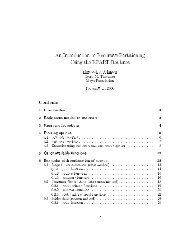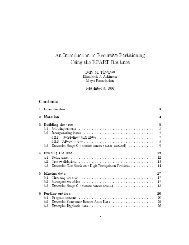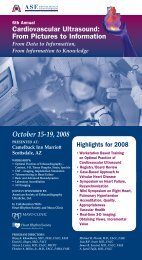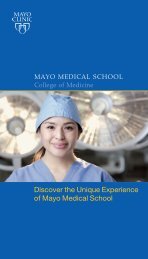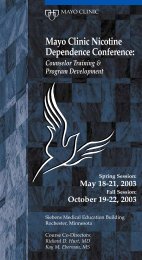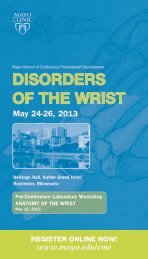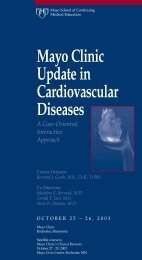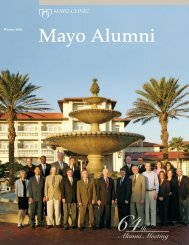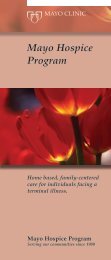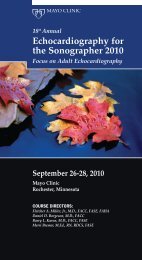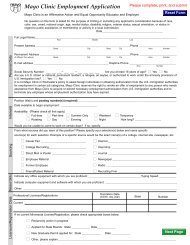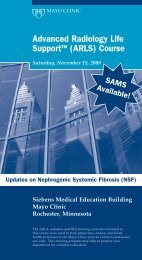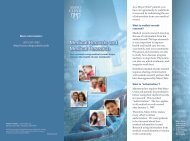Mayo Alumni Magazine 2002 Spring - MC4409-0402 - Mayo Clinic
Mayo Alumni Magazine 2002 Spring - MC4409-0402 - Mayo Clinic
Mayo Alumni Magazine 2002 Spring - MC4409-0402 - Mayo Clinic
Create successful ePaper yourself
Turn your PDF publications into a flip-book with our unique Google optimized e-Paper software.
Therapy Program at <strong>Mayo</strong>, Dr. Bender<br />
obtained a medical degree from the<br />
University of Nebraska. She then<br />
returned to <strong>Mayo</strong> <strong>Clinic</strong> for residencies<br />
in internal medicine and diagnostic<br />
radiology.<br />
“I believe the most valuable gift I<br />
received from the <strong>Mayo</strong> PT program<br />
was an understanding of how our<br />
<strong>Mayo</strong> staff treat and meet the needs of<br />
our patients,” says Dr. Bender. “In a<br />
way, I feel I am returning the wonderful<br />
gift given to me many years ago.”<br />
Dr. Bender has served <strong>Mayo</strong> <strong>Clinic</strong><br />
in many capacities over the years,<br />
including chairing the Physician<br />
Leadership Subcommittee and<br />
serving as a professor of radiology in<br />
<strong>Mayo</strong> Medical School.<br />
<strong>Mayo</strong> <strong>Clinic</strong> publishes book<br />
on <strong>Mayo</strong> Brothers’ heritage<br />
The <strong>Mayo</strong> Brothers’ Heritage: Quotes<br />
and Pictures, a book highlighting the<br />
teachings and wisdom of Dr. William<br />
J. <strong>Mayo</strong> and Dr. Charles H. <strong>Mayo</strong>,<br />
was recently published.<br />
Through photography and quotes,<br />
the new book, published by <strong>Mayo</strong><br />
<strong>Clinic</strong>, captures the vision and values<br />
of the <strong>Mayo</strong> brothers. Excerpts from<br />
the book focus on developing the<br />
integrated practice model and the<br />
importance of education.<br />
“In preparing this publication, we<br />
reviewed the collected papers and<br />
other excerpts of Dr. William J. <strong>Mayo</strong><br />
and Dr. Charles H. <strong>Mayo</strong>,” says<br />
Thomas Habermann, M.D., a <strong>Mayo</strong><br />
<strong>Clinic</strong> hematologist and lead author<br />
of the book. “In this review, we<br />
discovered that many familiar<br />
quotations reveal even greater insight<br />
within the fuller context of<br />
statements. Also, many previously<br />
unpublished photographs reveal the<br />
depth and subtleties of the <strong>Mayo</strong><br />
brothers.”<br />
Where possible, the book includes<br />
citations and dates to familiarize<br />
readers with the context of the quotes<br />
and pictures. The quotations are<br />
unaltered from their original<br />
wording.<br />
“There is not necessarily<br />
chronological congruence between<br />
each photograph and its associated<br />
excerpt,” says Renee Ziemer, a <strong>Mayo</strong><br />
<strong>Clinic</strong> historian and co-author of the<br />
book. “Instead, our pairing of<br />
photographs and excerpts reflects our<br />
interpretation of the spirit in the<br />
words and images.”<br />
The collection of photographs and<br />
quotes was originally presented to<br />
the <strong>Mayo</strong> <strong>Clinic</strong> Department of<br />
Medicine Grand Rounds as a<br />
program for <strong>Mayo</strong> <strong>Clinic</strong> Heritage<br />
Days in October 2000.<br />
The book cover illustration is<br />
based on the mural entitled, “My<br />
Brother and I.” The mural, located in<br />
the Gonda Building in Rochester,<br />
depicts the life and work of the<br />
<strong>Mayo</strong> brothers. The book is a 113-<br />
page, 10-inch-by-10-inch, hard cover.<br />
Retail price is $24.95. Revenue from<br />
the book will be used to support<br />
<strong>Mayo</strong> programs such as medical<br />
research and education. Copies of the<br />
book may be purchased in <strong>Mayo</strong><br />
<strong>Clinic</strong> gift shops, Barnes & Noble in<br />
downtown Rochester or online at<br />
Amazon.com.<br />
Gene discovery shows<br />
heart failure cause,<br />
suggests treatments<br />
United States and German<br />
scientists have discovered how a<br />
genetic defect causes dilated<br />
cardiomyopathy (DCM), a form of<br />
heart failure that claims 10,000<br />
American lives each year.<br />
The findings, published in the<br />
Jan. 29, <strong>2002</strong>, edition of Circulation:<br />
Journal of the American Heart<br />
Association, suggest how existing<br />
medications could help patients with<br />
DCM, a condition in which the heart<br />
becomes greatly enlarged and loses its<br />
ability to pump blood efficiently.<br />
“We predict that drugs that lower<br />
blood pressure and the heart’s overall<br />
workload will not only improve<br />
symptoms but lessen heart muscle<br />
damage in DCM patients with this<br />
genetic abnormality,” says<br />
Timothy Olson, M.D., a <strong>Mayo</strong> <strong>Clinic</strong><br />
cardiovascular disease specialist and<br />
one of the study’s two lead authors.<br />
“By establishing how the disease<br />
develops in these patients, this study<br />
provides direction both for improving<br />
treatment and long-term research.<br />
The study of 350 unrelated<br />
patients with DCM, conducted in<br />
collaboration with the Technical<br />
University of Braunschweig and the<br />
University of Utah, identified three<br />
patients who had distinct defects in<br />
the same gene. The work builds upon<br />
research first reported by <strong>Mayo</strong> <strong>Clinic</strong><br />
in the early 1990s that showed at least<br />
20 to 30 percent of DCM cases spring<br />
from an abnormal gene. While eight<br />
other genes associated with DCM<br />
have been identified, two of them<br />
through research involving <strong>Mayo</strong><br />
<strong>Clinic</strong> investigators, the current study<br />
is the first to shed light on the<br />
mechanism by which a defective<br />
gene causes the disease.<br />
<strong>Spring</strong> <strong>2002</strong> <strong>Mayo</strong> <strong>Alumni</strong> 27



